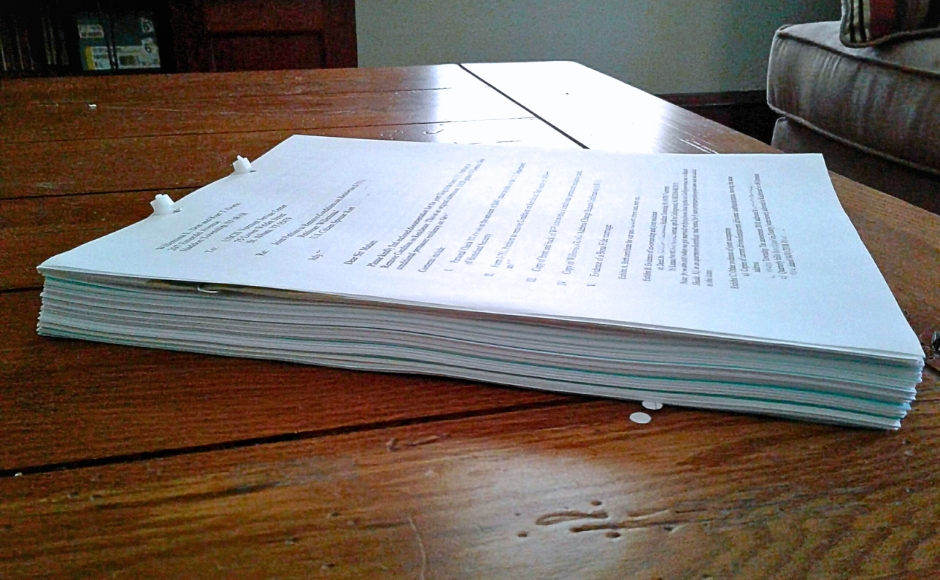By Willemijn Don-Goetz
When I first arrived in the United States as an international student, I passed by a post office every day.
“Apply for a passport here!” it said on the banner outside.
“Well that’s easy,” I thought, “when I’m ready, and if I want to, I know where to go for a passport.”
But, as I discovered, it wasn’t that easy to obtain a U.S. passport.
Before I could apply for a passport, first, I would have to become a U.S. citizen — and becoming a U.S. citizen was not something I could simply decide to do. I had to be eligible to apply for citizenship.
As it turns out, only those who have had a Green Card for five years (three, in certain circumstances) are eligible to apply for citizenship. At the time, I wasn’t eligible for a Green Card, let alone citizenship.
If you’re born an American, I don’t blame you for not knowing the detailed rules that of the citizenship process. Unless you’re an immigration lawyer, or are engaged/married to a non-citizen, how would you know? I was born a citizen of the Netherlands, and couldn’t tell you what it takes to become a Dutch citizen by naturalization.
Through my journey to American residency and citizenship, I have since learned a thing or two about immigration rules. I decided to publish my story because so many Americans I know don’t have the first clue why “just getting citizenship” is not as easy as it sounds.
What follows is not an immigration lawyer’s explanation of immigration rules. It is one highly-educated, white, European, Christian woman’s personal story of an immigration case, which was ultimately very uncomplicated, yet more complicated than many might think.
From international student to university employee
I first came to the United States on a student visa, called an F-1, for a one-year master’s degree program. After that year, I returned home, but decided to apply for Ph.D. programs in the United States. I was accepted and moved back to the U.S. the following September, again on an F-1 student visa.
When I graduated in 2012, I was offered a position at a state university. My student visa allowed me to obtain a one-year work authorization as “Optional Practical Training” for my job.
After that year, I was hired by a small, private liberal arts college that renewed my contract twice. Each time, I had to obtain another J-1 visa, a one-year, temporary visa for professors. In those 11 years, I spent about $2,000 in visa costs.
At this point, a lot of my American friends asked when I would apply for citizenship. After all, I had been in this country legally for more than 10 years. I had been paying taxes for the better part of that time, since, like many international students, I paid taxes on my scholarship, and later, on my salary.
However, I was not eligible to apply for permanent residency, let alone citizenship. My non-immigrant visas were based on my presumed return to my home country, and provided no path to becoming a legal, permanent resident.
Each year, as my contract was running out, I had to make tentative plans to return to the Netherlands. It’s a perfectly safe place where my family lives, and which has a lot of societal advantages; it’s just not where my professional life is anymore.
Some people are hired by a company or institution that sponsors them for a work visa, such as an H-1B visa. Nationwide, only 85,000 of those visas are available annually.
H-1B visas are desirable because they are so-called “dual intent” visas, and allow you to apply for a Green Card, if your employer is willing to sponsor you. Universities are exempt from the cap on H1-B visas, but the institution where I worked was unwilling to sponsor me for a Green Card.
However, I did get lucky in a different way: I met a wonderful American man, we fell in love, and in 2016, we got married. With an American husband, I was finally eligible to apply for a Green Card based on “close family ties.”

Building a family under government oversight
After I was married to an American, friends again asked me whether I had become a citizen yet.
Some assumed I could take my marriage certificate to the post office and apply for an American passport right there. Others, slightly better informed, suggested taking the certificate to immigration services so I could walk out of the building with a Green Card.
Unfortunately, it’s not that easy. Each of the steps we needed to take has its own potential complication.
“Petition to Sponsor Alien Relative” (I-130)
First, my husband filed a “Petition to Sponsor Alien Relative” (I-130). This application currently costs $675 (with a $50 discount if filed online), plus the cost of an official wedding certificate. This petition must be accompanied by “proof of a bona fide marriage.”
“Petition to Register Permanent Residence or Adjust Status” (I-485)
Simultaneously, I filed a “Petition to Adjust Status” (I-485). This currently costs $1,440, plus $950 for any child under 14 (which didn’t apply to me). It is important to note that adjustment of status from visa to permanent residency only works if you have a status from which to make adjustment, the consequences of which we will see later.
“Affadavit of Support” (I-864)
My husband had to submit an “Affadavit of Support” proving that he made more than 125 percent of the poverty guidelines for our household size, assuring the government that I would not become a public charge by relying on food stamps, Medicaid, or other forms of support.
Medical Exam
I had to undergo a medical exam. U.S. Citizenship and Immigration Services (USCIS) does not charge a fee for the medical forms, which sounds great until you realize they can only be completed by specially licensed doctors who don’t do that work for free.
With no set fee, costs vary widely: I got quotes ranging from $275 to $450, excluding additional possible costs for vaccines, treatment of any illness, medical imaging, etc. The results of the exam are handed to you in a sealed envelope, so you hope and pray the doctor checked all the right boxes and included all the right information.
Sitting in limbo
After my petition was submitted, I entered a time of limbo. My original visa ran out, so I was technically “out of status” even though my Green Card application was in process.
Leaving the country while the application is pending can be considered “abandoning your application,” so I had to stay. I was able to receive “advance parole” — authorization to travel abroad while my application was pending — at a cost of $630. (It used to be free.)
Since my visa was no longer valid, I couldn’t work or obtain a driver license. I submitted an additional petition to receive an employment authorization card, which I received about three months later. For me, that was free, but these days, it costs an additional $260.
Official interview
A few months after submitting the application, we had to go to the USCIS office for an interview to determine the validity of our marriage. I was approved.
Conditional Green Card
We were lucky in that this step only took a few months. Some petitions are left pending for months to years.
Some get delayed by “Requests for Additional Evidence” — anything from a mistake on your form, or a forgotten copy of your vaccine registry, to additional evidence that your marriage is not a sham.
If your petition is denied, you have the right to appeal that decision.
“Petition to Remove Conditions” (I-751)
I received a two-year conditional Green Card, since we had only been married a few months at the time of our interview. Before my two-year card expired, I had to submit a “petition to remove conditions” (I-751), in which I had to prove, through extensive documentation, that my marriage was legitimate.
The window to submit this petition opened exactly 90 days before the two-year card expired, and closed when the card expired. Upon approval of this petition, which took about 18 months, I received a Green Card that is valid for 10 years.
Some people are called for an additional interview; others are approved based on their documentation alone. It currently costs $750 to file a petition to remove conditions on a Green Card.
Application for Naturalization (N-400)
Only after I had been a permanent resident for three years (reduced from five years since I obtained my Green Card through marriage), I was eligible to apply for naturalization by submitting petition N-400.
The current cost for this is $710 online, or $760 if you file a paper form. Certain applicants are eligible to apply for a reduced fee of $380.
I became a U.S. citizen in 2021, five years after my marriage.
Green Card holders who, for whatever reason, do not apply for citizenship, must renew their Green Cards every 10 years. This costs $500 (including a biometric fee), with a discount for filing online.
Pitfalls and Complications
Since I have walked down this path, I am very aware of all the difficulties that accompany each step of the way. Several possible complications can make an immigration case much harder:
Cost
Today, someone who follows the same path I did will spend about $4,000 to go from being a non-citizen married to a U.S. citizen to full U.S. citizenship (plus visa fees for studying and working here before starting the permanent residency process).
For the USCIS forms alone, every adult in a family pays their own fees; children under 14 pay a reduced, but considerable, fee. Lawyer fees are extra. Our case was relatively simple, so we decided to do everything ourselves. If there are complications, lawyer costs can skyrocket.
Adjustment of status
Adjustment of status only works if you have a status from which to adjust, which is important in relation to the DACA (Deferred Action for Childhood Arrivals) immigration policy.
If you arrived as a baby or small child, brought here by family members who crossed borders without inspection, you have no status. Even if a family member or employer is able to sponsor you, or you are now married to a U.S. citizen, this process is generally not available to you.
Moreover, visa violations can trigger harsh bans when you leave the country. You could be barred from returning to the United States for a decade, even a lifetime. In some cases you can get waivers, but guess what? That’s going to cost you a lot of money.
Limitations of support
My husband had no trouble fulfilling the financial obligation required to apply for my citizenship. But what if your sponsor is working hard for minimum wage, or less? What if they were laid off, and are unable to find a different job?
What if they’re disabled, and unable to make ends meet? You could get a co-sponsor, but what if all the people in your social circle only have just enough to provide for their own households?
Health status
I was lucky. I had all my vaccines in order, and no communicable diseases. Sometimes, if you miss some vaccinations, your insurance will reimburse you. If your family is unable to pay for healthcare, and you’re without insurance, out-of-pocket costs can become prohibitive.
Impact of lapses and expirations
If you let your Green Card expire, you do not immediately lose your status, but it will cause you issues when traveling, renewing your drivers’ license, or working. You’d better have an extra $500-plus on hand when the card is about to expire.
Accessibility challenges
With every petition or application comes an appointment to have your biometrics taken. It is not scheduled at a place or time convenient to you. Missing the appointment will result in denial of your petition. You’ll need a job that allows you to take time off and a way to get to the facility.
Clerical concerns
If you do not respond to a letter from USCIS, this can “make you deportable.” But what if you moved and the letter was sent to your old address?
This actually happened to me. Despite having filed all the required change-of address forms, my reminder to apply for “removal of conditions” was sent to my old address. Mail from USCIS does not get forwarded, and I received this letter only because our former neighbor knew our new address.
Unforced errors
Innocuous mistakes can jeopardize your application. Using a social security number your parents said is yours, but isn’t, constitutes a crime. If you register to vote because the lady at the DMV offers you the form, and your immigration documents aren’t in order, that could bar you from ever becoming a citizen.
Access to documents
You must provide very specific documents, such as your birth certificate — even if, for example, you were born in war-ravaged Syria, and are now a naturalized Swedish citizen.
Maybe your parents just didn’t take those documents with them on the perilous journey fleeing their home. It may be possible to overcome these challenges, but will no doubt require expensive legal support just to try.
More limbo
Anytime your petition needs adjudication by a judge, which happens if you appeal an immigration decision, you will have to wait for a very long time. There are not enough immigration judges to make this a quick process.
In the meantime, leaving the country without authorization while in the process of applying for a Green card is considered “abandoning your application,” which leads to a situation where you could be out of status, and waiting in legal limbo for a very long time.
There are a multitude of other complications I can’t even think of.
Compliance doesn’t guarantee citizenship
I’m a legal immigrant. I “did everything the right way.” It cost me a pretty sum of money, but it was worth it to me to be with my husband and live here.
But I will be the first to acknowledge that I am also lucky: being European, white, educated, and financially okay is culturally preferred here. Nobody stopped me on the street while my visa was no longer valid and while I was waiting for my Green Card petition to be adjudicated.
Having gone through the process, I can totally see where people stumble, do things the wrong way, make mistakes, miss payments or deadlines, or have things go wrong through no fault of their own.
I strongly believe this should not deny immigrants a path to legal residency.



